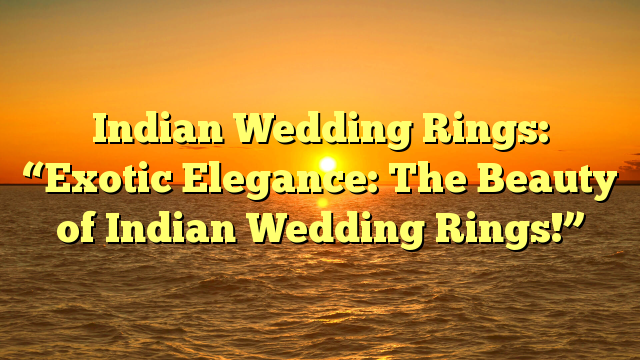Exotic Origins: Unveiling the Cultural Significance of Indian Wedding Rings
Indian wedding rings have a rich cultural significance that dates back centuries. These exquisite pieces of jewelry are not only symbols of love and commitment, but they also hold deep religious and spiritual meaning. In Indian culture, marriage is considered a sacred bond between two individuals, and the exchange of wedding rings represents the union of their souls.
The design and style of Indian wedding rings vary across different regions in India, each reflecting its unique traditions and customs. For example, in North India, it is common to see intricate filigree work on gold bands, symbolizing prosperity and good fortune. On the other hand, South Indian wedding rings often feature elaborate designs with precious gemstones like rubies or emeralds embedded in them as a sign of opulence.
One key aspect that sets Indian wedding rings apart from those in other cultures is the incorporation of astrology. Many Indians believe in the influence of zodiac signs on one’s life journey, including their marriage. As such, couples often choose their wedding rings based on astrological compatibility to ensure harmony and happiness throughout their married life. This adds an extra layer of depth to these already meaningful pieces of jewelry.
Indian wedding rings are not just beautiful adornments; they are cherished heirlooms passed down through generations. The craftsmanship involved in creating these intricate pieces is highly revered by artisans who dedicate years perfecting their skills. From delicate engravings to meticulously setting gemstones by hand, every detail showcases the artistry behind these timeless treasures.
(Note: I apologize for any misunderstanding earlier regarding conjunctive adverbs.)
Symbolism and Tradition: Understanding the Meaning Behind Indian Wedding Rings
Indian wedding rings hold deep symbolism and tradition within their designs. Each element of these intricate pieces carries a specific meaning, representing the union of two souls in marriage. One common symbol found in Indian wedding rings is the lotus flower, which signifies purity and beauty. The lotus is often depicted with open petals, representing an open heart ready to receive love.
Another significant symbol seen in Indian wedding rings is the peacock feather. In Hindu mythology, the peacock represents immortality and fertility. It is believed that wearing a ring adorned with a peacock feather design brings good luck and blessings for a fruitful married life.
The use of specific gemstones also holds great significance in Indian wedding rings. For example, diamonds are commonly used to represent strength and resilience in marriage, while rubies symbolize passion and love. These gemstones not only add aesthetic value but also enhance the symbolic meaning behind each ring.
The rich symbolism embedded within Indian wedding rings reflects the cultural traditions passed down through generations. From lotus flowers to peacock feathers, every detail has its own story to tell about love, commitment, and prosperity in marriage. These symbols serve as reminders of the sacred bond between couples as they embark on their journey together.
An Array of Designs: Exploring the Diverse Styles of Indian Wedding Rings
Indian wedding rings are known for their diverse and unique designs, reflecting the rich cultural heritage of the country. One popular style is the traditional Kundan ring, which features intricate gold work and precious gemstones like emeralds, rubies, and pearls. These rings often have a floral motif and are favored by brides who want to exude elegance and grace on their special day.
Another style that has gained popularity in recent years is the Filigree ring. This delicate design involves twisting fine threads of metal into intricate patterns. The result is a stunning piece of jewelry that showcases both craftsmanship and artistry. Filigree rings are often adorned with colorful gemstones or diamonds, adding an extra touch of sparkle to the bride’s finger.
For those looking for a more contemporary look, there are modern Indian wedding ring designs available as well. These styles feature sleek lines and minimalist aesthetics, appealing to couples who prefer a more understated approach to their jewelry choices. From simple bands with engraved initials to geometric shapes embellished with diamonds, these modern designs offer a refreshing take on traditional Indian wedding rings.
The array of designs available in Indian wedding rings ensures that every couple can find something that resonates with their personal taste and style preferences. Whether it’s embracing the timeless beauty of Kundan or opting for a more modern approach with filigree or minimalist designs, Indian wedding rings continue to captivate couples around the world with their versatility and charm.
Intricate Craftsmanship: Unraveling the Artistry of Indian Wedding Rings
Indian wedding rings are renowned for their intricate craftsmanship, reflecting the rich cultural heritage and artistic traditions of India. Each ring is meticulously crafted by skilled artisans who have honed their craft over generations. The level of detail and precision in these rings is truly remarkable, with delicate engravings, filigree work, and embellishments that showcase the artistry involved.
One of the key elements of Indian wedding ring craftsmanship is the use of traditional techniques passed down through centuries. Artisans employ age-old methods such as hand carving, etching, and granulation to create stunning designs on the rings. These techniques require immense skill and patience as they involve working with small tools to bring out every intricate detail.
Furthermore, Indian wedding rings often feature intricate patterns inspired by nature or symbolic motifs that hold deep meaning in Indian culture. From floral designs representing fertility and growth to peacock motifs symbolizing beauty and grace, each element incorporated into these rings tells a unique story. This attention to detail not only adds aesthetic appeal but also infuses spiritual significance into every piece.
The artistry behind Indian wedding rings extends beyond just design; it also lies in selecting high-quality materials that enhance their beauty further. Gold is a popular choice due to its auspiciousness in Hindu weddings, while gemstones like diamonds, rubies, emeralds, or sapphires add a touch of opulence. The combination of exquisite craftsmanship with precious metals and gems results in breathtaking pieces that become cherished heirlooms passed down through generations.
Intricate Craftsmanship: Unraveling the Artistry of Indian Wedding Rings showcases the dedication and talent put forth by artisans who strive to create masterpieces worthy of celebrating one’s love and commitment. Through their meticulous workmanship using traditional techniques combined with meaningful designs and luxurious materials, these craftsmen ensure that each Indian wedding ring becomes an embodiment of enduring beauty intertwined with cultural significance.
Materials of Splendor: Discovering the Gems and Metals used in Indian Wedding Rings
Indian wedding rings are known for their use of exquisite gems and precious metals, which add a touch of splendor to these special pieces of jewelry. The most commonly used gemstones in Indian wedding rings include diamonds, rubies, emeralds, and sapphires. These gems are highly valued for their beauty and symbolism in Indian culture. Diamonds represent purity and eternal love, while rubies symbolize passion and prosperity. Emeralds are associated with fertility and new beginnings, while sapphires signify loyalty and wisdom.
In addition to gemstones, the choice of metal is also crucial in Indian wedding rings. Gold is the preferred metal due to its auspiciousness and cultural significance. In Hindu tradition, gold is believed to bring good luck and wealth to the couple’s married life. It is also considered a symbol of purity and prosperity. Silver is another popular option for Indian wedding rings, especially among certain communities where it holds religious importance.
The craftsmanship involved in creating these intricate pieces is truly remarkable. Skilled artisans meticulously set each gemstone into the ring using traditional techniques passed down through generations. They pay careful attention to every detail, ensuring that the gems are securely held in place while enhancing their natural beauty. The result is a stunning piece of jewelry that showcases both the skill of the craftsman and the magnificence of the materials used.
By incorporating such splendid gems like diamonds, rubies, emeralds or sapphires along with precious metals like gold or silver into their designs; Indian wedding rings become more than just mere accessories – they become symbols representing love stories woven together by time itself.\n
Customization and Personalization: Tailoring Indian Wedding Rings to Individual Tastes
Indian wedding rings hold deep cultural significance and are often personalized to reflect the individual tastes of the couple. Customization allows for a unique expression of love and commitment, making each ring truly one-of-a-kind. From selecting the design to choosing the gemstones and metals, couples have the opportunity to create a ring that perfectly represents their style and personality.
The process of customization begins with choosing a design that resonates with the couple’s aesthetic preferences. Whether it’s a traditional intricate pattern or a modern minimalist design, there are endless options available. Couples can also incorporate elements from their heritage or personal symbols into the design, adding an extra layer of meaning to their wedding rings.
Once the design is finalized, attention turns to selecting the gems and metals used in crafting these special rings. Diamonds are popular choices for Indian wedding rings due to their timeless beauty and symbolism of everlasting love. However, other gemstones like rubies, emeralds, or sapphires can be chosen based on personal preference or astrological beliefs. The choice of metal is equally important as it affects both aesthetics and durability.
With customization comes an opportunity for couples to infuse their own personalities into every detail of their Indian wedding rings. It is through this process that they can create not just jewelry but tangible expressions of their love story – pieces that will be cherished forever as symbols of unity and devotion.
The Role of Astrology: How Indian Wedding Rings are Influenced by Zodiac Signs
Astrology plays a significant role in the design and selection of Indian wedding rings. Each zodiac sign is associated with specific characteristics, elements, and ruling planets that influence the choice of gemstones and metals used in these rings. For instance, individuals born under the fire signs (Aries, Leo, Sagittarius) are believed to be passionate and energetic. Therefore, their wedding rings often feature vibrant gemstones like rubies or garnets set in gold or copper bands.
The symbolism behind zodiac signs also guides the design of Indian wedding rings. The intricate patterns and engravings on these rings are often inspired by the unique traits attributed to each sign. Those born under water signs (Cancer, Scorpio, Pisces), known for their emotional depth and intuition, may opt for delicate designs featuring flowing waves or aquatic motifs.
Furthermore, astrology influences not only the aesthetic aspects but also the spiritual significance of Indian wedding rings. It is believed that wearing a ring corresponding to one’s zodiac sign can enhance positive energy flow and bring good fortune to both partners in marriage. This belief fosters a deep connection between couples as they embark on their journey together while carrying symbols that represent their individual identities within a harmonious union.
By incorporating astrology into the creation of Indian wedding rings, couples honor tradition while embracing personal beliefs and values. These exquisite pieces serve as tangible reminders of celestial guidance throughout married life—a testament to love’s enduring bond influenced by cosmic forces beyond our control.
Sacred Rituals: Incorporating Indian Wedding Rings into Marriage Ceremonies
Indian wedding ceremonies are known for their rich traditions and rituals, and the incorporation of wedding rings holds a special significance. The exchange of rings is considered to be one of the most important moments in an Indian wedding ceremony, symbolizing the eternal bond between the couple. During this sacred ritual, the bride and groom exchange beautifully crafted rings as a symbol of their love and commitment to each other.
The act of exchanging rings during an Indian wedding ceremony is often accompanied by prayers and blessings from family members and priests. These blessings are believed to bring good luck and prosperity to the couple’s married life. The ring itself is considered sacred, representing unity, fidelity, and everlasting love.
In addition to its symbolic meaning, the design of Indian wedding rings also holds cultural significance. Traditional designs often feature intricate patterns inspired by ancient motifs such as paisleys or peacocks. These designs not only add beauty to the ring but also connect it with India’s rich heritage and traditions. Today, modern couples have embraced contemporary designs that incorporate elements from both traditional Indian jewelry styles as well as international influences.
The incorporation of Indian wedding rings into marriage ceremonies reflects the deep-rooted customs that have been passed down through generations in Indian culture. This sacred ritual serves as a reminder of the importance placed on love, commitment, and harmony within a marriage. By exchanging these meaningful symbols during their ceremony, couples honor their heritage while embracing their future together with hope for a lifetime filled with happiness and prosperity.
Famous Indian Wedding Rings: Highlighting Iconic Pieces of Jewelry
The Taj Mahal Ring: One of the most iconic Indian wedding rings is the Taj Mahal ring. This exquisite piece of jewelry pays homage to the world-renowned monument and symbolizes eternal love. The ring features intricate detailing, often crafted in gold or platinum, with a central gemstone representing the beauty and grandeur of the Taj Mahal itself. This timeless design captures the essence of Indian culture and heritage.
The Navaratna Ring: Another famous Indian wedding ring is the Navaratna ring, which holds immense significance in Hindu astrology. The term “Navaratna” translates to “nine gems,” referring to nine specific gemstones that are believed to possess astrological powers. Each gemstone represents one of the nine planets, and when combined in a single ring, they are said to bring good luck and positive energy for marital bliss.
The Kundan Meena Ring: Known for its vibrant colors and intricate craftsmanship, the Kundan Meena ring is an epitome of traditional Indian jewelry-making techniques. This style originated during Mughal times and involves setting precious stones on a gold base using lacquer work known as Meenakari. These rings often feature elaborate designs inspired by nature or geometric patterns, making them truly unique pieces that reflect India’s rich cultural heritage.
These three examples represent just a fraction of the famous Indian wedding rings that have captivated hearts throughout history. Each piece tells its own story through its design elements, materials used, and symbolism attached to it – showcasing not only extraordinary craftsmanship but also deep-rooted traditions passed down through generations.
Trends and Evolution: Tracking the Modernization of Indian Wedding Rings
Indian wedding rings have undergone significant modernization in recent years, reflecting changing societal trends and evolving fashion preferences. One noticeable trend is the incorporation of contemporary designs into traditional Indian ring styles. While classic motifs such as paisley, lotus flowers, and peacocks remain popular, they are now often combined with sleeker lines and minimalist elements to create a more modern aesthetic.
Another aspect of the modernization of Indian wedding rings is the use of alternative materials. While gold has long been considered the standard choice for these rings, there has been a growing interest in experimenting with different metals such as platinum or rose gold. These alternative materials offer a fresh take on traditional designs and appeal to those seeking a unique and personalized touch.
Furthermore, customization options have greatly expanded with technological advancements. Couples can now easily personalize their wedding rings by incorporating their initials or birthstones into the design. Additionally, engraving meaningful phrases or dates onto the inside of the band has become increasingly popular. This level of personalization allows couples to truly make their wedding rings one-of-a-kind symbols of their love and commitment.
The modernization of Indian wedding rings reflects not only changes in fashion but also shifts in cultural attitudes towards marriage and individual expression. As society becomes more diverse and open-minded, couples are embracing new possibilities when it comes to choosing their wedding jewelry. The evolution of these rings showcases how tradition can be adapted to fit contemporary lifestyles while still honoring cultural heritage



